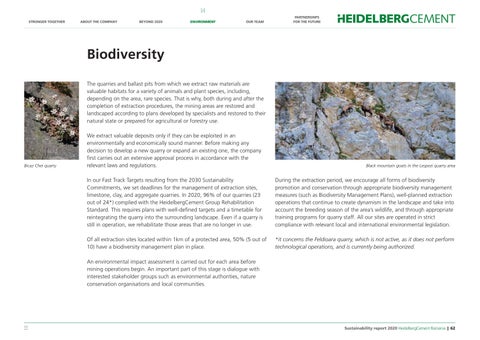STRONGER TOGETHER
ABOUT THE COMPANY
BEYOND 2020
ENVIRONMENT
OUR TEAM
PARTNERSHIPS FOR THE FUTURE
Biodiversity The quarries and ballast pits from which we extract raw materials are valuable habitats for a variety of animals and plant species, including, depending on the area, rare species. That is why, both during and after the completion of extraction procedures, the mining areas are restored and landscaped according to plans developed by specialists and restored to their natural state or prepared for agricultural or forestry use.
Bicaz Chei quarry
We extract valuable deposits only if they can be exploited in an environmentally and economically sound manner. Before making any decision to develop a new quarry or expand an existing one, the company first carries out an extensive approval process in accordance with the relevant laws and regulations.
Black mountain goats in the Lespezi quarry area
In our Fast Track Targets resulting from the 2030 Sustainability Commitments, we set deadlines for the management of extraction sites, limestone, clay, and aggregate quarries. In 2020, 96% of our quarries (23 out of 24*) complied with the HeidelbergCement Group Rehabilitation Standard. This requires plans with well-defined targets and a timetable for reintegrating the quarry into the surrounding landscape. Even if a quarry is still in operation, we rehabilitate those areas that are no longer in use.
During the extraction period, we encourage all forms of biodiversity promotion and conservation through appropriate biodiversity management measures (such as Biodiversity Management Plans), well-planned extraction operations that continue to create dynamism in the landscape and take into account the breeding season of the area’s wildlife, and through appropriate training programs for quarry staff. All our sites are operated in strict compliance with relevant local and international environmental legislation.
Of all extraction sites located within 1km of a protected area, 50% (5 out of 10) have a biodiversity management plan in place.
*it concerns the Feldioara quarry, which is not active, as it does not perform technological operations, and is currently being authorized.
An environmental impact assessment is carried out for each area before mining operations begin. An important part of this stage is dialogue with interested stakeholder groups such as environmental authorities, nature conservation organisations and local communities.
Sustainability report 2020 HeidelbergCement Romania | 62










